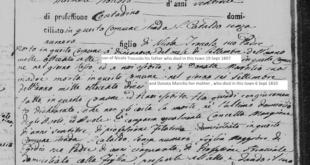Last month, we went over some tricky problems with handwriting in old Italian records. We have to use some simple techniques to help you read the records with less effort and more accuracy.
These techniques may not work in every situation but they are a standard logic to help you reduce the number of possible letters to choose from in each word. You may see a very poorly written word that looks at first glance like Mrysiclush, but that doesn’t make sense in Italian no matter what part of the record you are reading.
Handwriting tip #1 is the easiest way to figure out surnames, which are the words on the document that are not part of a language class, and so you have to figure them out for yourself. The tip is: use the name index. You may be looking at a marriage record and you can’t read the bride’s mother’s surname. That’s important information, so you need to figure out what this guy was scribbling that day. He had one too many espressos and wrote all over the place and you can’t figure it out. What to do?
Go to the index of the names for that year, which could be at the beginning or end of the record group you are in. It doesn’t matter. Any index will do for this town. If the mother-in-law is listed in a marriage record, chances are that she has cousins, nieces and nephews in the town who share her surname. If she’s from a different town, you may need to check the familysearch catalog for a “film” from that other town to see her name more commonly.
IF you are lucky, the name index for one year of this town will be in surname order. If you’re like me, they won’t be. If the index is grouped by first letter of the surname, you can see every name that starts with “G” in the index. Perhaps a different clerk made the index and wrote the name more clearly. If the name index has every surname sorted in alpha order, you can read and look for names that are similar to the mother-in-law surname you can’t read. If you search all the “G” names and find nothing, check other letters. Maybe you are seeing “GUANGI” but the name is actually “QUANGI” with a capital Q that looks like a G.
Tip #2 can help if you can’t find that surname in the index, or if you are looking at any other word that is not a surname. It’s common sense, but you need to look at the same document for known words and compare the penmanship with the word you can’t read. This bum writes his lower case “b” in a strange way! Ah, here is the surname “Abbinante”. Now I see how he writes the letter “b”. The same guy writes capital “F” with all the flourish of the Declaration of Independence … aha! Here is the first name “Francesco” with the same swoop!
Tip #3 is also common sense. Look at other records that were clearly written by a different person, and see if any known words looks like the one you can’t read. A number of things repeat from record to record. Use them to your advantage. The name of the Mayor (Sindaco) will be on almost every page of the records you are looking at. Find a different record writer and see how they wrote the mayor’s name, then go back to the cruddy record you need to read and see how those letters were written by that guy. This goes hand-in-hand with Tip #4.
Tip #4 is related to the position of the word in this document. What piece of information is written there? If it’s the year, you can limit what you see based on what words should appear in a year. (They love to write numbers as words.) If it’s the date of the event “oggi or ieri” you should easily tell one from the other, because all other words would not appear there. “Mascolino” or “femminile” on a birth record. You get the general idea. If you know some words, you can use those in tip #2 and help decipher other letters based on the words you know for sure. We rarely use the witnesses in Italian records, but if you see a known surname, you can use the penmanship to figure out other words. Since only certain words can appear in certain places on the document, you can rule out a lot of other words and narrow it down.
You can use records a year or more, even several years away from the record you’re working on, to find other people who write records perhaps with better handwriting. If the town you are researching is large, with hundreds of records in one year, you will probably find several sets of handwriting very easily.
Goob luch…I mean good luck!
 Fra Noi Embrace Your Inner Italian
Fra Noi Embrace Your Inner Italian








